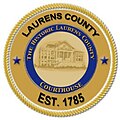2010 census
At the 2010 census, there were 66,537 people, 25,525 households, and 17,707 families living in the county. [13] The population density was 93.2 inhabitants per square mile (36.0/km2). There were 30,709 housing units at an average density of 43.0 per square mile (16.6/km2). [14] The racial makeup of the county was 70.4% white, 25.4% black or African American, 0.3% Asian, 0.2% American Indian, 0.1% Pacific islander, 2.3% from other races, and 1.3% from two or more races. Those of Hispanic or Latino origin made up 4.1% of the population. [13] In terms of ancestry, 11.8% were American, 9.8% were Irish, 9.6% were German, and 8.8% were English. [15]
Of the 25,525 households, 32.9% had children under the age of 18 living with them, 46.6% were married couples living together, 17.2% had a female householder with no husband present, 30.6% were non-families, and 26.1% of all households were made up of individuals. The average household size was 2.51 and the average family size was 3.00. The median age was 39.9 years. [13]
The median income for a household in the county was $37,529 and the median income for a family was $45,769. Males had a median income of $36,807 versus $26,799 for females. The per capita income for the county was $18,757. About 14.1% of families and 19.2% of the population were below the poverty line, including 31.0% of those under age 18 and 14.6% of those age 65 or over. [16]
2000 census
At the 2000 census, [17] there were 69,567 people, 26,290 households, and 18,876 families living in the county. The population density was 97 people per square mile (37 people/km2). There were 30,239 housing units at an average density of 42 per square mile (16/km2). The racial makeup of the county was 71.57% White, 26.23% Black or African American, 0.28% Native American, 0.15% Asian, 0.05% Pacific Islander, 0.95% from other races, and 0.78% from two or more races. 1.94% of the population were Hispanic or Latino of any race.
There were 26,290 households, out of which 32.50% had children under the age of 18 living with them, 51.10% were married couples living together, 15.60% had a female householder with no husband present, and 28.20% were non-families. 24.60% of all households were made up of individuals, and 9.80% had someone living alone who was 65 years of age or older. The average household size was 2.55 and the average family size was 3.01.
In the county, the population was spread out, with 25.30% under the age of 18, 9.20% from 18 to 24, 28.50% from 25 to 44, 23.80% from 45 to 64, and 13.20% who were 65 years of age or older. The median age was 36 years. For every 100 females, there were 93.60 males. For every 100 females age 18 and over, there were 89.70 males.
The median income for a household in the county was $33,933, and the median income for a family was $39,739. Males had a median income of $30,402 versus $21,684 for females. The per capita income for the county was $15,761. About 11.60% of families and 14.30% of the population were below the poverty line, including 19.60% of those under age 18 and 13.50% of those age 65 or over.
As of December 2017, the county unemployment rate was 4.4%. [18]






